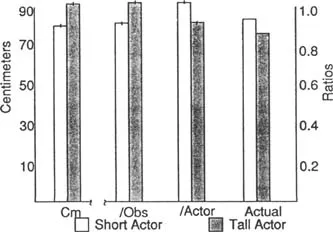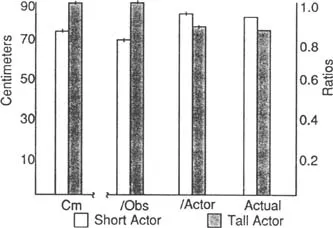
eBook - ePub
Studies in Perception and Action IV
Ninth Annual Conference on Perception and Action
John M. Kennedy, Mark Schmuckler, John M. Kennedy, Mark Schmuckler
This is a test
Share book
- 408 pages
- English
- ePUB (mobile friendly)
- Available on iOS & Android
eBook - ePub
Studies in Perception and Action IV
Ninth Annual Conference on Perception and Action
John M. Kennedy, Mark Schmuckler, John M. Kennedy, Mark Schmuckler
Book details
Book preview
Table of contents
Citations
About This Book
As busy as teachers and scholars are, rarely do they find the time to sample widely from the table of scientific inquiry. This book offers the opportunity to do just that. The fourth volume in the "Studies in Perception and Action" series, it contains a collection of posters presented at the Ninth International Conference on Perception and Action, sponsored by the International Society for Ecological Psychology. Like its predecessor, this volume is a collection of short reports, mostly empirical in nature. The reports are considerably larger than the abstracts presented in the proceedings of many conferences, and provide the authors with opportunities to present arguments, methods, results, and conclusions in condensed forms.
Frequently asked questions
How do I cancel my subscription?
Can/how do I download books?
At the moment all of our mobile-responsive ePub books are available to download via the app. Most of our PDFs are also available to download and we're working on making the final remaining ones downloadable now. Learn more here.
What is the difference between the pricing plans?
Both plans give you full access to the library and all of Perlego’s features. The only differences are the price and subscription period: With the annual plan you’ll save around 30% compared to 12 months on the monthly plan.
What is Perlego?
We are an online textbook subscription service, where you can get access to an entire online library for less than the price of a single book per month. With over 1 million books across 1000+ topics, we’ve got you covered! Learn more here.
Do you support text-to-speech?
Look out for the read-aloud symbol on your next book to see if you can listen to it. The read-aloud tool reads text aloud for you, highlighting the text as it is being read. You can pause it, speed it up and slow it down. Learn more here.
Is Studies in Perception and Action IV an online PDF/ePUB?
Yes, you can access Studies in Perception and Action IV by John M. Kennedy, Mark Schmuckler, John M. Kennedy, Mark Schmuckler in PDF and/or ePUB format, as well as other popular books in Psychologie & Histoire et théorie en psychologie. We have over one million books available in our catalogue for you to explore.
Information
Section II: Perception - Action Coupling
II.A: Affordances
Kinematic Specification Of Affordances
Researchers have been scrupulous in motivating studies of affordances on the basis of the physics of animal-environment relations (e.g., Mark, 1987; Warren, 1984). Through such studies we are beginning to understand the physics that define affordances. Yet understanding of the causal physics is not sufficient for an ecological theory of perception. A tenet of the ecological approach is that affordances are specified; that the physical relations exist in 1:1 correspondence to structures in energy arrays. This should motivate studies of patterns in stimulus arrays that may specify affordances. However, this issue has received little attention.
The information that specifies affordances for another person's actions must be public (Rochat, 1995; Stoffregen, Sheng, & Gorday, 1995). That is, it must be available at distal points of observation. Thus, patterns in the optic array may specify affordances for others. This could provide a convenient opportunity to investigate the specification of at least one class of affordances; affordances for the actions of others. Our study constitutes a qualitative step in this direction. We reasoned that relations between actor and environment might be perceived on the basis of relational movement trajectories (kinematics) of actor and environment. This lead to the hypothesis that observers should be able to perceive affordances for actors from displays that preserve only these relational kinematics. We studied perception of affordances for sitting (Mark, 1987).
Experiment 1
Method
One tall (195 cm) and one short (153 cm) actor were filmed against a dark background, while wearing reflectors on major body joints. Actors were filmed at different distances so that they had the same on-screen height. Each actor engaged in three behaviors; 1) marching in place, 2) squatting and returning to an upright stance, and 3) sitting down and standing up from an unseen stool, which was covered in black velvet. Behaviors were executed next to an experimental chair which had a height-adjustable seat pan (Mark, 1987); reflectors were attached to the corners of the chair, and to the seat pan. The seat pan was moved continuously up and down as the actors behaved. Sixteen observers made nine judgments of each actor's maximum sitting height. On each trial O adjusted the video display (by instructing E to pause the tape) so that it was at what they judged to be the actor's maximum sitting height. Each of sixteen participants made 36 judgments of each actor, half with the seat pan ascending and half with it descending.
Results
The results are summarized in Figure 1, which presents mean judgments across trials and observers. The judgments for each actor were scaled in three ways: in centimeters, as a proportion of each observer's own leg length, and as

Figure 1. Results of Experiment 1.
a proportion of each actor's leg length. Judgments reflected the actors' actual sitting capabilities (right hand columns in Figure 1) only when scaled in terms of actor leg length.
Experiment 2
In Experiment 1 Os might have adjusted the seat pan until it was at the same height as the reflector on the actor's hip. Another possible problem was the constant relation between the on-screen size of the “image” of the chair and that of the actors, which resulted from the fact that the actors' behaviors were carried out in a fixed location. In Experiment 2 there was not a constant relation between the on-screen position of the actors and the chair.
Method
New tapes were made. The actors walked to and fro along the camera's line of sight, so that their images expanded and contracted relative to the chair.
Results
The data are summarized in Figure 2. The results were essentially identical to those of Experiment 1. Judgments reflected the actors' actual sitting capabilities (right hand columns in Figure 2) only when scaled in terms of actor leg length.

Figure 2. Results of Experiment 2.
Discussion
In both experiments, observers differentiated the kinematic displays for the two actors. This was true despite the fact that the two actors' images were the same size on the monitor. From Experiment 1 we can conclude that judgments were based on some property of the displays that was super-ordinate to image size (or, more precisely, that was super-ordinate to the vertical extent of the group of white spots that corresponded to each actor). The results of Experiment 2 suggest that judgments of affordances for the actors are possible even when there were dramatic and continuous changes in relative image sizes of actor and chair. These experiments indicate that kinematic patterns in the optic array can be sufficient for the perception of affordances for other people.
References
Mark, L. M. (1987). Eyeheight-scaled information about affordances: A study of sitting and stair climbing. Journal of Experimental Psychology: Human Perception and Performance, 13, 361–370.
Rochat, P. (1995). Perceived reachability for self and for others by 3- to 5-year-old children and adults. Journal of Experimental Child Psychology, 59, 317–333.
Stoffregen, T. A., Sheng, Y-Y., & Gorday, K. M. (1995, July). Perceiving affordances for another person's action. In B. G. Bardy, R. B. Bootsma, & Y. Guiard (Eds.), Studies in perception and action III (pp. 153–156). Mahwah, NJ: Lawrence Erlbaum Associates, Inc.
Warren, W. H. (1984). Perceiving affordances: Visual guidance of stair climbing. Journal of Experimental Psychology: Human Perception & Performance, 10, 683–703.
Perceiving Action Boundaries In The Volleyball Block
Warren (1984) proposed to analyze affordances in terms of the dynamics of the actor-environment system. An affordance is determined by the fit between the material properties of the environment and those of the actor, yielding critical points at which a phase transition to another mode of action occurs. Contemporary affordance studies have mainly concentrated on anthropometric action-related properties of the actor. In the task under investigation (stair climbing, walking through apertures) anthropometric properties were found to be important for the realization of the affordance. It is clear however that the actor's potential ability to generate forces influences the action, hence should influence the perception. So far little work has been done on the importance of kinetic properties of the actor in the perception of affordances (Konczak et al., 1992). To address this problem kinetic properties should play an important role in the task used.
When a ball approaches the net in volleyball, the defender has to decide what action to undertake: To jump and block or to retreat and dig the ball to prevent it from falling on his side of the field. It is thus highly important for the volleyball player to know at which height a ball is blockable and at which it is not, for the critical height at which the ball is no longer blockable corresponds to a phase transition in behavior. Performing a volleyball block involves both kinematic demands (reach height of the actor) and kinetic demands (the actors jumping ability).
This study addresses two questions: i) Are subjects able to perceive their action boundaries in blockability, and if so: ii) What actor-related property can account for their faculty to perceive blockability? The first question requires a positive answer otherwise blockability is not an affordance. With respect to the second question, kinetic properties like impulse should play an significant role in the perception of the affordance of blockability.
Method
Eleven male subjects were asked to indicate whether they thought a volleyball (diameter 21 cm) hanging from the ceiling was blockable or not. ‘Blockable’ was defined as the height where the subject could jump and reach for the mid-line of the ball (a black strip of 1 cm wide) with both hands. Using the simple up-down method (Levitt, 1970) perceived maximum blockable height (PBH) for each subject was established. Maximum block height (BH) was measured by asking the subject to perform a maximum block. Both assessments were held in different rooms so subjects were never able to see whether their PBH matched BH. Furthermore the subject's mass and height were measured. From the height jumped impulse could be calculated. All data collection was done three times on three consecutive days.
Results
Our first question was: Are subjects able to perceive blockability? The data reveal that subjects are highly accurate in their perception of maximum block height ( M = 2.78 m, SD = 0.11 m) compared to their achieved block height ( M = 2.70 m, SD = 0.10 m). Subjects slightly overestimate PBH by less then 3%. Regression analysis (Figure 1) indicates a direct linear relation between PBH and BH (R2 = .598; p < .0053). The correlation coefficient of PBH and BH is .77 (p < .01), underlining this linear relationship.
What property can account for the subject's ability to perceive the height he can block? Correlation coefficients were established for the different anthropometric and kinetic properties measured. This shows that PBH is correlated to impulse (correlation coefficient = 0.71; p < .05). No relatio...